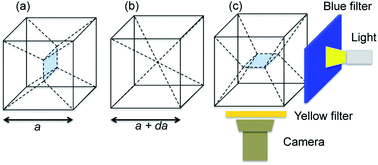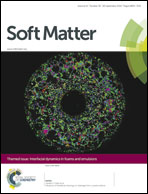Oil repartition in a foam film architecture†
Abstract
The propagation and distribution of oil inside the aqueous network of a foam is investigated in the case where oil can invade the foam without breaking it. The oil is injected into an elementary foam architecture of nine foam films and four vertices obtained by plunging a cubic frame in a foaming solution. The frame is then deformed to trigger a film switching (topological rearrangement named T1) and oil redistribution through this process is reported. Depending on the relative ratio of injected oil and water, different behaviours are observed. For small amounts of oil, a globule is trapped in one single node whereas for large oil volumes, it invades the four nodes of the foam film assembly. In both these cases, a T1 process does not change the oil distribution. However, for intermediate volumes, oil initially trapped in one node is able to propagate to the neighbouring nodes after the T1 process. This important observation shows that topological rearrangements, which naturally occur in foams when they evolve with time or when they flow, do affect the distribution of the third phase that they carry. These different regimes are captured by simple modeling based on the capillary pressure balance inside the foam network. Moreover, in the large-oil-volume limit, a transient situation is evidenced where an oil film is trapped within the freshly formed water film. This oil film modifies the dynamics of the T1 process and can be stable for up to a few minutes. We expect this mechanism to have consequences on the rheological properties of oil-laden foams. Film rupture dynamics is also experimentally captured.


 Please wait while we load your content...
Please wait while we load your content...